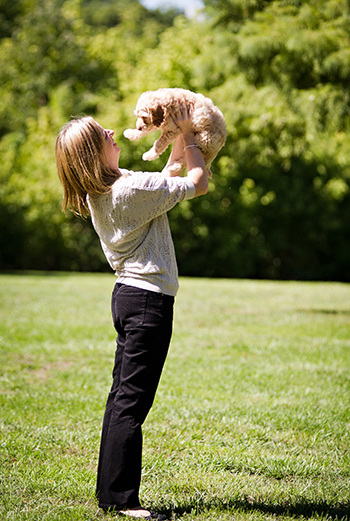
We look at several characteristics when considering the appearance of an Australian labradoodle.
General Appearance: Must appear athletic and graceful with a compact body displaying substance with medium boning. Should not appear cloddy or heavy nor overly fine. A distinctive feature of this breed is their coat, which is non-shedding and easy to manage.
Temperament: Extremely clever, sociable, comical, joyful, energetic when free and soft and quiet when handled. They should approach people in a happy friendly manner, keen and easy to train. They should display an intuition about their family members or handler’s current emotional state or needs. This ability to “know” is what has made the Australian Labradoodle an excellent dog for individuals with special needs.
Mouth: Must be a scissor bite. Upper teeth to just overlap the bottom teeth.
Nose: Should be large, of square appearance and fleshy.
Neck: Well proportioned of good strength, moderately long lending an air of elegance, slightly arched and flow into shoulders with no appearance of abruptness.
Forequarters: Shoulders blades and upperarms to be the same length, and shoulders should be well laid back. Elbows are set close to the body. Forelegs to be straight when viewed from the front. Toeing in our out is a fault.
Body: Height (to wither) as to length (from sternum to point of buttock) should appear square and compact. Deep chest and well sprung. There should be a good tuck up. Loins should be strong and muscular.
Hindquarters: In profile, the croup is nearly flat, slight sloping of the croup is acceptable. Stifles should be moderately turned to propel forward movement, and hindquarters well muscled for power in movement. Hock to heel should be strong and short being perpendicular to the ground. View from the rear should be parallel to each other, must not be cow-hocked.
Feet: The feet are of medium size, round with well-arched toes having elastic and thick pads. The feet should not turn in or out.
Tail: The tail should follow the topline in repose or when in motion. It may be carried gaily, but should not curl completely over the back. Tip of the tail should not touch the back nor curl upon itself.
Movement: Trotting gait is effortless, smooth, powerful and coordinated in mature dogs. Should have a good reach in front and drive from behind for forward motion. Sound free movement and a light gait is essential.
Information republished with permission from Australian Labradoodle Association of America.






